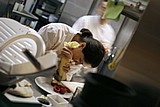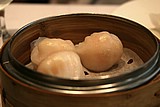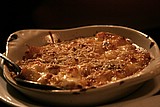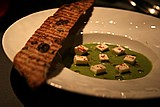Home |
Restaurants by City
|
Food Photography |
Archive | Philosophy |
![]()
Right now we are eating in Seattle, Washington.
|
Monday
2005
Permalink
|
Lampreia, Seattle, WA, tasted on March 26, 2005 — Derrick from Obsession with Food and I are bringing you a joint blog entry. I've covered Lampreia enthusiastically here on tastingmenu before, so this time we're leaving the words to Derrick, while the pictures are mine. Here's Derrick's report from our meal: When Melissa and I planned a five-day visit with our Seattle-based friends Pavel and Kathleen, we only had only one thing on our must-do list. We wanted to eat at Lampreia. And we wanted to go with Hillel. I learned about Lampreia through Hillel's blog of eating adventures around the world, and Chef Carsberg's Tyrol-inspired restaurant sits high on his list of favorite haunts. That's a noteworthy recommendation in its own right, but the cookbook from Carsberg and the tastingmenu.com team renewed my interest in eating at this medium-sized Belltown establishment. Hillel and I met at last year's Fancy Food Show—his frequent dining partner Lauren is a friend of mine from back when I was famous —and he and I have kept in touch. I knew he couldn't pass up a meal at one of his favorite restaurants. He and his wife Debbie and their friends dine there often ("I've been here four times," said his college-bound sister visiting from the East Coast), and they urged us to let the chef cook whatever he wanted. This is good advice. With no menu, you can't build up any preconceptions about what a meal might offer. You wait, slightly giddy. A dish appears. What is it? You don't know until the waiter steps back, waits for conversation to die, and announces the new arrival, simultaneously quiet and triumphant.
I did notice one problem with the surprise menu. We didn't know quite how much wine we needed. Hillel and I each brought a bottle, I the superbly balanced 2002 Donnhoff Riesling Spätlese from the Oberhauser Brücke vineyard, Hillel an equally well-balanced Pride Merlot, possibly the best Merlot I've ever tasted. But it wasn't quite enough. Another bottle would have been nice, I think. This meal ranks high in my pantheon of great life experiences. The sense of balance and harmony that registered with virtually every dish was astonishing. I envy Hillel, who not only lives close enough to eat there, but takes advantage of it often. Midway through the meal, he said to me quietly, "The people in this town have no idea what they've got here." I imagine he's right. I'll just add that one of the only things I enjoy more than eating a wonderful meal is sharing that experience with someone else and watching their reaction as they get a firsthand understanding of my excitement. This meal was no exception, and that's essentially the purpose of this website (in a more scalable fashion).
|
|||
Our Sponsors
Free Car Listings – Hot Tubs – Stools – Saunas – Bar Stools - Calendar and Event Schedules - Food Events and Calendars - Wine Events and Calendars - Digital Photography Resources - Software for Advertisers - Jewish Gifts and Judaica - Howard Stern Podcast - ponytailed blogger Jonathan Schwartz

Browse tastingmenu
Home |
Restaurants by City X |
Food Photography |
Archive | Philosophy |
![]()
Free eBooks: All About Apples
| Autumn Omakase
More:
Discussion |
Cool Food T-Shirts |
Ingredients
| Markets |
Recipes
Search |
Blog FAQ |
Other
Blogs
Best of tastingmenu
|
City View
Entry: July 6, 2006 |
Blue Plate
Entry: June 19, 2006 |
L'Atelier de Joël Robuchon
Entry: July 18, 2006 |
Browse by City
Boston | Chicago | Houston | Las Vegas | Los Angeles | Maui | New York | Philadelphia | Portland | San Francisco | Seattle | Toronto | Utah | Vancouver | Washington D.C.
Bangkok | Beijing | Hong Kong | Seoul | Tokyo
Amsterdam | Berlin | Italy | London | Madrid | Paris | Vienna
Browse by Month
2006
2005
2004
2003
2002
2001
Comments, questions, or feedback:
info / at / tastingmenu / dot / com
All pages Copyright (c) 2001-2006 tastingmenu.com
Last modified 01/30/07.














